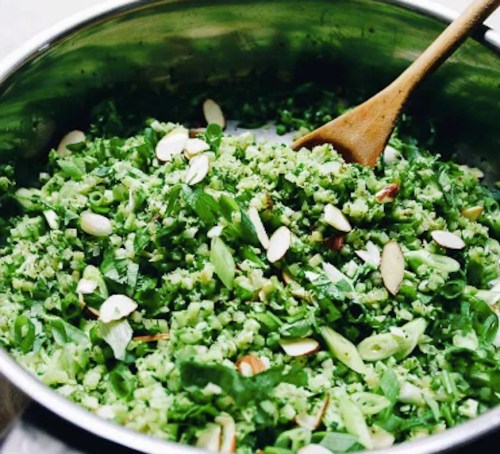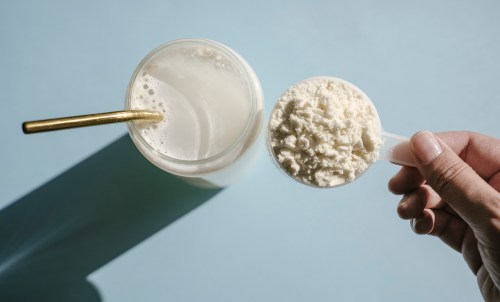Our editors independently select these products. Making a purchase through our links may earn Well+Good a commission
While all macronutrients are important, many healthy eating experts see fiber as the crown jewel of good health. Dietitians, nutritionists, gut health experts…they all wax poetic about the benefits of fiber, which include supporting optimal gut health, lowering inflammation, and maintaining a healthy metabolism.
For many people, adding fiber to their meal typically comes in two forms: a salad or a side of veggies. But there’s another, more under-the-radar way to add fiber to your meals: riced vegetables. You may have already experimented with riced cauliflower, but I’m here to sing the praises of its oft-overlooked cousin, riced broccoli.
Riced broccoli is exactly what it sounds like: broccoli that’s been prepared in a way that has the look and texture of traditional rice. It doesn’t require any other ingredients to make it either; it’s literally just broccoli in rice form. Here, registered dietitian Karen Collins, RD, who specializes in heart health and cancer prevention, shares everything you need to know about the underdog alt-rice.
How riced broccoli compares to other types of rice
Even though white and brown rice aren’t unhealthy foods, Collins says there are several reasons why someone may want to opt for broccoli rice instead. “One reason is that broccoli—and many other non-starchy vegetables—are lower in carbohydrates than white or brown rice,” Collins says, which makes it an easy replacement for those foods.
A quick comparison between traditional rice and riced broccoli shows that a half cup of white rice has 22 grams of carbohydrates while a half cup of riced broccoli has just seven grams. Thus, if you follow the ketogenic diet, for example, riced broccoli is a way to still enjoy dishes normally made with rice, like stir-fry or burrito bowls.
“Evidence does not show that low-carbohydrate diets are necessarily better for weight loss, blood sugar control, or other aspects of health. [But] for people who tend to eat a lot of carbohydrates, especially refined grains, replacing some of it with vegetables could be a good move,” Collins says. Especially since vegetables like broccoli are good sources of fiber—great for digestive and gut health—along with other antioxidants and nutrients. (More on those benefits in a sec!)
Riced broccoli is also very similar nutrition-wise to riced cauliflower, Collins says, making them practically interchangeable. However, she notes that there are some key differences between the two foods. Riced cauliflower is higher in fiber and vitamin C, while riced broccoli provides beta-carotene and lutein, which isn’t found in cauliflower and is linked to boosting brain health. Because both riced veggies are full of health benefits, you can’t go wrong with either choice; switch it up to keep your meals interesting!
Other health benefits of riced broccoli
1. Riced broccoli has calcium.
Besides being a good source of fiber and vitamin C, Collins says there are many other benefits to adding riced broccoli to your meals. One is that it’s a good source of calcium, with 48 milligrams in a 100-gram serving. (You want to aim to get 1,200 milligrams per day.) Calcium is important to supporting bone health, especially in postmenopausal women.
2. It’s a good source of vitamin a.
This comes back to the beta-carotene Collins mentioned. That comes from the vitamin A in riced broccoli. One half cup of riced broccoli has 641 microunits, which is almost what you need for the entire day. Not only does vitamin A help reduce inflammation in the body, it’s important for eye health, too.
3. it could help lower the risk for cancer.
Because broccoli is high in antioxidants, like all veggies, Collins says that eating it regularly as part of a healthy diet could help reduce the risk of cancer. But she does offer up one caveat to this, saying that scientific research shows that eating raw or lightly steamed riced broccoli (or raw cruciferous vegetables in general) is really the best way to get these benefits.
How to make and cook riced broccoli
Because riced broccoli is increasing in popularity, it’s becoming easier to find already prepped for you at the grocery store, typically located in the frozen food section. A few brands to keep an eye out for: Green Giant, Cece’s, Full Green, and Birds Eye.
“If you’re buying frozen riced broccoli, most of it started out as 100 percent vegetables with no sauces, salt, or other flavorings. But some is now coming with flavorings like processed cheese that adds a lot of sodium, making this less healthful than it might seem,” Collins says. So just keep that in mind when purchasing (and when in doubt, reference the label to see if the product fits in with your particular health needs).
Broccoli rice is also relatively easy to make your own by using your food processor, blender, or chopping it by hand. If you have a food processor or blender, Collins says to simply wash your broccoli, break it into pieces, add it to your food processor or blender, and then pulse it for three minutes—that’s literally all it takes.
If you don’t have a food processor or blender, you can also chop the broccoli finely with a knife, although this is a bit more tedious. Collins says using a box grater to grate the broccoli stems until it resembles rice is another way to make it.
Once you have your raw broccoli rice ready to go, there are a few different cooking methods you can try. One easy way is to steam it in the microwave. Just add your riced broccoli to a bowl with a little cooking oil and cover it with plastic wrap. Then, just microwave it for two minutes. Many of the store-bought riced broccoli can easily be prepared in the microwave similarly as well.
Another way to cook it: saute it. Simply add your riced broccoli a skillet on the stove with a little bit of cooking oil on medium-high heat. Saute it until the texture softens, which should take just a few minutes. This is an especially helpful cooking method if you’re making stir-fry because you can add your other veggies in the same skillet to cook together.
If you’re using your riced broccoli in a casserole, simply mix it right in with the other ingredients and then pop it in the stove, cooking it at the temperature the casserole recipe indicates.
3 recipes to try to put your broccoli rice to good use

1. BROCCOLI FRIED RICE
If you’ve never experimented with riced broccoli before, this is a good recipe to start with. Here, it’s used as a straight- forward swap for white rice in a fried rice recipe. It’s cooked with ghee, coconut aminos, and toasted sesame oil so it soaks in lots of flavor while the texture is softening.

2. BROCCOLI RICE CASSEROLE
This is another great recipe to start with because it combines the riced broccoli with whole grain rice, so you’re easing into it without going full-force. It’s full of other healthy ingredients too, like carrots, onions, and several anti-inflammatory spices.

3. RICED BROCCOLI CAULIFLOWER RISOTTO
If you’re looking for some healthy comfort food, this is it. Unlike traditional risotto that cooks on the stove and requires constant stirring and attention, this dish is oven-baked so you can let it just cook for 30 minutes and then enjoy it when it’s done.
Have another idea for cooking it? Share it in Well+Good’s Cook With Us Facebook group.
Sign Up for Our Daily Newsletter
Get all the latest in wellness, trends, food, fitness, beauty, and more delivered right to your inbox.
Got it, you've been added to our email list.











